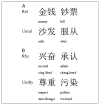Modality- and task-specific brain regions involved in Chinese lexical processing
- PMID: 18823229
- PMCID: PMC3277453
- DOI: 10.1162/jocn.2009.21141
Modality- and task-specific brain regions involved in Chinese lexical processing
Abstract
fMRI was used to examine lexical processing in native adult Chinese speakers. A 2 task (semantics and phonology) x 2 modality (visual and auditory) within-subject design was adopted. The semantic task involved a meaning association judgment and the phonological task involved a rhyming judgment to two sequentially presented words. The overall effect across tasks and modalities was used to identify seven ROIs, including the left fusiform gyrus (FG), the left superior temporal gyrus (STG), the left ventral inferior frontal gyrus (VIFG), the left middle temporal gyrus (MTG), the left dorsal inferior frontal gyrus (DIFG), the left inferior parietal lobule (IPL), and the left middle frontal gyrus (MFG). ROI analyses revealed two modality-specific areas, FG for visual and STG for auditory, and three task-specific areas, IPL and DIFG for phonology and VIFG for semantics. Greater DIFG activation was associated with conflicting tonal information between words for the auditory rhyming task, suggesting this region's role in strategic phonological processing, and greater VIFG activation was correlated with lower association between words for both the auditory and the visual meaning task, suggesting this region's role in retrieval and selection of semantic representations. The modality- and task-specific effects in Chinese revealed by this study are similar to those found in alphabetical languages. Unlike English, we found that MFG was both modality- and task-specific, suggesting that MFG may be responsible for the visuospatial analysis of Chinese characters and orthography-to-phonology integration at a syllabic level.
Figures








Similar articles
-
Cultural constraints on brain development: evidence from a developmental study of visual word processing in mandarin chinese.Cereb Cortex. 2010 May;20(5):1223-33. doi: 10.1093/cercor/bhp186. Epub 2009 Sep 22. Cereb Cortex. 2010. PMID: 19773547 Free PMC article.
-
Specialization of phonological and semantic processing in Chinese word reading.Brain Res. 2006 Feb 3;1071(1):197-207. doi: 10.1016/j.brainres.2005.11.097. Epub 2006 Jan 19. Brain Res. 2006. PMID: 16427033 Free PMC article.
-
Neural signatures of phonological deficits in Chinese developmental dyslexia.Neuroimage. 2017 Feb 1;146:301-311. doi: 10.1016/j.neuroimage.2016.11.051. Epub 2016 Nov 24. Neuroimage. 2017. PMID: 27890803
-
Developmental differences of neurocognitive networks for phonological and semantic processing in Chinese word reading.Hum Brain Mapp. 2009 Mar;30(3):797-809. doi: 10.1002/hbm.20546. Hum Brain Mapp. 2009. PMID: 18330872 Free PMC article.
-
A meta-analysis of fMRI studies on Chinese orthographic, phonological, and semantic processing.Neuroimage. 2012 Oct 15;63(1):381-91. doi: 10.1016/j.neuroimage.2012.06.047. Epub 2012 Jul 1. Neuroimage. 2012. PMID: 22759996 Review.
Cited by
-
Similar alterations in brain function for phonological and semantic processing to visual characters in Chinese dyslexia.Neuropsychologia. 2012 Jul;50(9):2224-32. doi: 10.1016/j.neuropsychologia.2012.05.026. Epub 2012 Jun 12. Neuropsychologia. 2012. PMID: 22698991 Free PMC article.
-
Phonological and morphological literacy skills in English and Chinese: A cross-linguistic neuroimaging comparison of Chinese-English bilingual and monolingual English children.Hum Brain Mapp. 2023 Sep;44(13):4812-4829. doi: 10.1002/hbm.26419. Epub 2023 Jul 23. Hum Brain Mapp. 2023. PMID: 37483170 Free PMC article.
-
The involvement of occipital and inferior frontal cortex in the phonological learning of Chinese characters.J Cogn Neurosci. 2011 Aug;23(8):1998-2012. doi: 10.1162/jocn.2010.21571. Epub 2010 Aug 31. J Cogn Neurosci. 2011. PMID: 20807053 Free PMC article.
-
Different patterns and development characteristics of processing written logographic characters and alphabetic words: an ALE meta-analysis.Hum Brain Mapp. 2014 Jun;35(6):2607-18. doi: 10.1002/hbm.22354. Epub 2013 Sep 16. Hum Brain Mapp. 2014. PMID: 24105858 Free PMC article.
-
The Brain Effective Connectivity of Chinese during Rhyming Task.PLoS One. 2016 Sep 1;11(9):e0162158. doi: 10.1371/journal.pone.0162158. eCollection 2016. PLoS One. 2016. PMID: 27583349 Free PMC article.
References
-
- Binder JR, Rao SM, Hammeke TA, Yetkin FZ, Jesmanowicz A, Bandettini PA, et al. Functional magnetic resonance imaging of human auditory cortex. Annals of Neurology. 1994;35:662–672. - PubMed
-
- Booth JR, Burman DD, Meyer JR, Gitelman DR, Parrish TB, Mesulam MM. Functional anatomy of intra- and cross-modal lexical tasks. Neuroimage. 2002;16:7–22. - PubMed
Publication types
MeSH terms
Substances
Grants and funding
LinkOut - more resources
Full Text Sources

